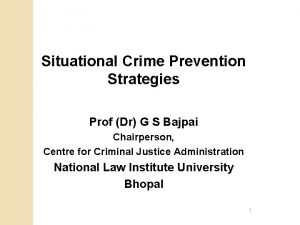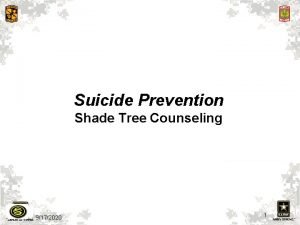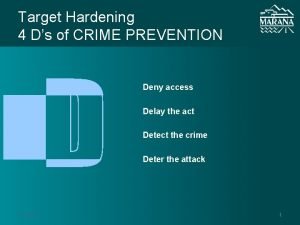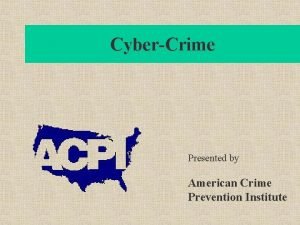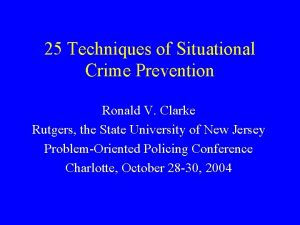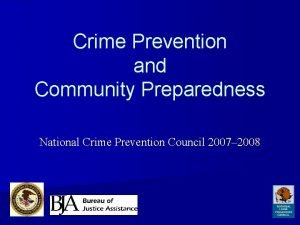Situational Crime Prevention Five Strategies and TwentyFive Techniques







- Slides: 7

Situational Crime Prevention Five Strategies and Twenty-Five Techniques Cornish and Clarke (2003)

Situational Crime Prevention Strategies and Techniques Cornish and Clarke (2003) Increase Effort Remove Excuses Increase Risk Strategies Reduce Stimulus Reduce Reward

Situational Crime Prevention Control Tools Universal measures to control tools and weapons used in crime: E. g. Access to guns and knives, electronic disabling of phones, cars, etc. Strategies and Techniques Harden Targets Cornish and Clarke Physical barriers to obstruct offender access to a potential target: (2003) Harden Targets E. g. Locks, Anti-robbery screens Control Tools Control Access Increase Effort Remove Excuses Increase Risk Strategies Reduce Stimulus Deflect Offenders Provide alternatives for activities: E. g. Youth meeting areas, litter bins, streaming music services. Deflect Offenders Increase Reduce Reward Screen Exits Control Access Barriers to access to vulnerable areas: E. g. Entry phones, Electronic keys, Alleygates. Screen Exits E. g. Electronic tags / devices in shops to prevent theft.

Situational Crime Prevention Strengthen Formal Surveillance Deterring unwanted activities through clearly-visible surveillance: E. g. Uniformed security guards, CCTV, alarms. Strengthen Formal Surveillance Strategies and Techniques Extend Guardianship Guardian Cornish and Clarke Extending the number of “eyes on the street” to ship (2003) enhance safety: E. g. Reporting suspicious incidents, Neighbourhood Watch, “Cell-phone surveillance” Assist Natural Surveillance Increase Effort Remove Excuses Increase Risk Strategies Utilise Site Managers People conduct soft surveillance in the course of their work. E. g. Attendants, maintenance workers, porters. Reward vigilance. Increase Risk Reduce Stimulus Utilise Site Managers Reduce Reward Reduce Anonymity Assist Natural Surveillance Making it easier for people to surveil areas as they go about their normal business. E. g. Improved street lighting, Defensible space, Reduce Anonymity Develop ways to increase people’s familiarity with each another. E. g. Identity cards in taxis, school uniforms.

Situational Crime Deny Benefits Prevention Strategies and Techniques Conceal Targets Cornish and Clarke Reduce chances of victimisation by keeping potential targets out of plain view: (2003) Conceal Targets Deterring offenders by denying them the benefits of crime: E. g. PIN numbers on debit cards, photos on credit cards, rapid graffiti removal, clothing ink tags. E. g. Unmarked bullion trucks, hiding jewellery, phones, etc. while walking alone, off-street parking. Deny Benefits Remove Targets Increase Effort Remove Excuses Increase Risk Strategies Disrupt Markets Reduce market for stolen goods to discourage burglary and theft: E. g. Licensing street vendors, monitoring pawn shops, identity cards for door-to-door salespeople. Reduce Reward Reduce Stimulus Disrupt Markets Reduce Reward Identify Property Remove Targets Reduce chances of victimisation by securing potential targets: E. g. Women’s refuges, not carrying cash in public, securing valuable property overnight. Identify Property Using indelible ownership marks on property to prevent reselling: E. g. Ultra-violet marking of computers etc.

Situational Crime Prevention Discourage Imitation Measures to prevent “copy-cat” offending: E. g. Rapid repair of vandalised property (“Broken Windows”), parental controls on TV programming. Strategies and Techniques Reduce Frustration and Stress Cornish andmood: Clarke Measures to calm / change people’s E. g. Improved street / workplace lighting, (2003) Reduce Stress online services to reduce queues, public seating, polite assistants. Discourage Imitation Avoid Disputes Increase Effort Remove Excuses Increase Risk Strategies Neutralise Peer Pressure Measures to reduce negative or promote positive influence of peers: E. g. Zero-tolerance of school bullying, anti-drug campaigns, “friends don’t let friends drink-and-drive”. Reduce Stimulus Neutralise Peer Pressure Reduce Reward Reduce Emotional Arousal Avoid Disputes Measures designed to prevent disputes arising: E. g. Fixed cab fares, traffic reduction measures, separating rival fans in stadia, reduced crowding in pubs. Reduce Emotional Arousal Measures to eliminate emotional responses: E. g. Banning hate speech, convicted paedophiles not housed near schools.

Situational Crime Prevention Control Drug Abuse Develop ways to control effects of drug and alcohol abuse: E. g. Legalising / licensing marijuana, free breathalyser tests in pubs, designated driver schemes, improved training for bartenders. Strategies and Techniques Set Rules Cornish and compliance: Clarke Clear and concise rules to encourage E. g. Signed student agreements, codes of conduct (2003) Set Rules for schools, organisations, etc. Control Drug Abuse Increase Effort Remove Excuses Increase Risk Strategies Reduce Stimulus Assist Compliance Measures that help people conform: E. g. Non-alcoholic drinks, litter bins, public lavatories. Assist Compliance Remove Excuses Promote Rules Make people aware of behavioural rules: E. g. Signs (“No parking”, “No smoking”). Reduce Reward Alert People’s Conscience Use people’s moral values to influence their behaviour: E. g. Warning signs for speeding, “Piracy is a crime” warnings on CDs and DVDs, “Please do not litter” appeals in public places.
